Trade names Velban, others MedlinePlus a682848 Molar mass 810.975 g/mol Biological half-life 24.8 hours (terminal) DrugBank DB00570 | AHFS/Drugs.com Monograph Formula C46H58N4O9 ATC code L01CA01 (WHO) Synonyms vincaleukoblastine | |
 | ||
Pregnancycategory AU: DUS: D (Evidence of risk) Legal status UK: POM (Prescription only)US: ℞-onlyIn general: ℞ (Prescription only) | ||
Vinblastine is a chemotherapy medication, typically used with other medications, to treat a number of types of cancer. This includes Hodgkin's lymphoma, non-small cell lung cancer, bladder cancer, brain cancer, melanoma, and testicular cancer. It is given by injection into a vein.
Contents

Most people experience some side effects. Commonly it causes a change in sensation, constipation, weakness, loss of appetite, and headaches. Severe side effects include low blood cell counts and shortness of breath. It should not be given to people who have a current bacterial infection. Use during pregnancy will likely harm the baby. Vinblastine works by blocking cell division.

Vinblastine was isolated in 1958. It is on the World Health Organization's List of Essential Medicines, the most effective and safe medicines needed in a health system. As of 2014 the wholesale cost in the developing world is about 7.70 and 31.70 USD per dose. In the United Kingdom it costs 13.09 pounds per 10 mg vial. It was originally obtained from the Madagascar periwinkle.
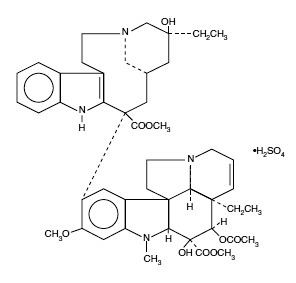
Medical uses
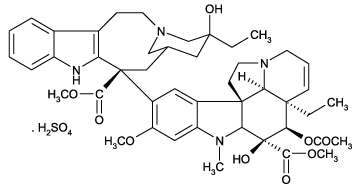
Vinblastine is a component of a number of chemotherapy regimens, including ABVD for Hodgkin lymphoma. It is also used to treat histiocytosis according to the established protocols of the Histiocytosis Association.
Side effects
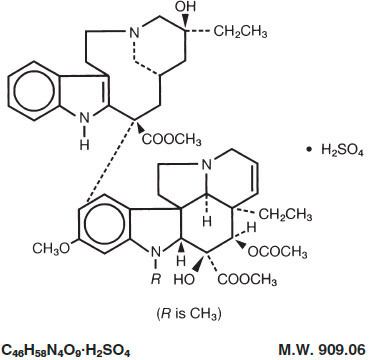
Adverse effects of vinblastine include hair loss, loss of white blood cells and blood platelets, gastrointestinal problems, high blood pressure, excessive sweating, depression, muscle cramps, vertigo and headaches.
Pharmacology

Vinblastine is a vinca alkaloid and a chemical analogue of vincristine. It binds tubulin, thereby inhibiting the assembly of microtubules. Vinblastine treatment causes M phase specific cell cycle arrest by disrupting microtubule assembly and proper formation of the mitotic spindle and the kinetochore, each of which are necessary for the separation of chromosomes during anaphase of mitosis. Toxicities include bone marrow suppression (which is dose-limiting), gastrointestinal toxicity, potent vesicant (blister-forming) activity, and extravasation injury (forms deep ulcers). Vinblastine paracrystals may be composed of tightly-packed unpolymerized tubulin or microtubules.
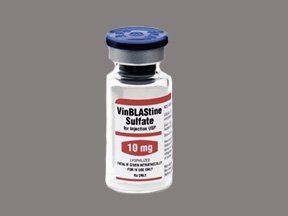
Vinblastine is reported to be an effective component of certain chemotherapy regimens, particularly when used with bleomycin, and methotrexate in VBM chemotherapy for Stage IA or IIA Hodgkin lymphomas. The inclusion of vinblastine allows for lower doses of bleomycin and reduced overall toxicity with larger resting periods between chemotherapy cycles.
Mechanism of action
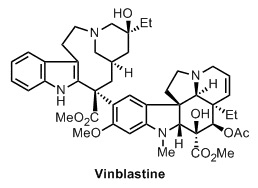
Microtubule-disruptive drugs like vinblastine, colcemid, and nocodazole have been reported to act by two mechanisms. At very low concentrations they suppress microtubule dynamics and at higher concentrations they reduce microtubule polymer mass. Recent findings indicate that they also produce microtubule fragments by stimulating microtubule minus-end detachment from their organizing centers. Dose-response studies further indicate that enhanced microtubule detachment from spindle poles correlate best with cytotoxicity.
Isolation and synthesis
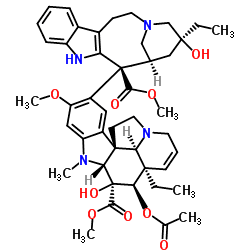
Vinblastine may be isolated from the Madagascar Periwinkle (Catharanthus roseus), along with several of its precursors- catharanthine and vindoline. Extraction is costly and yields of vinblastine and its precursors are low, although procedures for rapid isolation with improved yields avoiding auto-oxidation have been developed. Enantioselective synthesis has been of considerable interest in recent years, as the natural mixture of isomers is not an economical source for the required C16’S, C14’R stereochemistry of biologically active vinblastine. Initially, the approach depends upon an enantioselective Sharpless epoxidation, which sets the stereochemistry at C20. The desired configuration around C16 and C14 can then be fixed during the ensuing steps. In this pathway, vinblastine is constructed by a series of cyclization and coupling reactions which create the required stereochemistry. The overall yield may be as great as 22%, which makes this synthetic approach more attractive than extraction from natural sources, whose overall yield is about 10%. Stereochemistry is controlled through a mixture of chiral agents (Sharpless catalysts), and reaction conditions (temperature, and selected enantiopure starting materials).
History
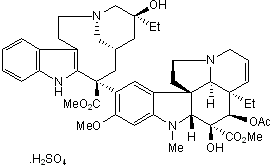
Vinblastine was first isolated by Robert Noble and Charles Thomas Beer at the University of Western Ontario from the Madagascar periwinkle plant. Vinblastine's utility as a chemotherapeutic agent was first suggested by its effect on the body when an extract of the plant was injected in rabbits to study the plant's supposed anti-diabetic effect. (A tea made from the plant was a folk-remedy for diabetes.) The rabbits succumbed to a bacterial infection, due to a decreased number of white blood cells, so it was hypothesized that vinblastine might be effective against cancers of the white blood cells such as lymphoma.
